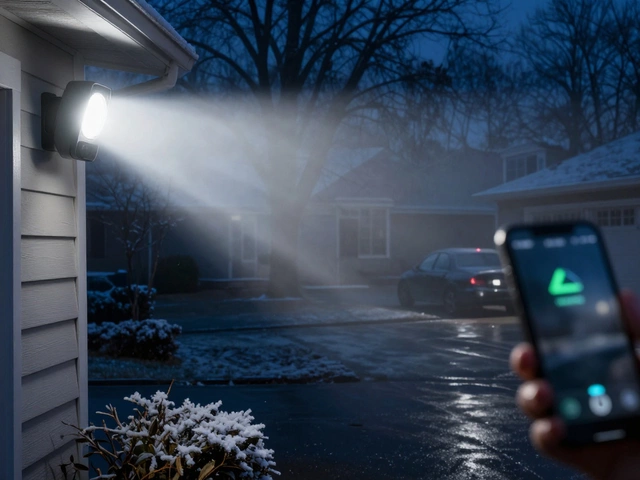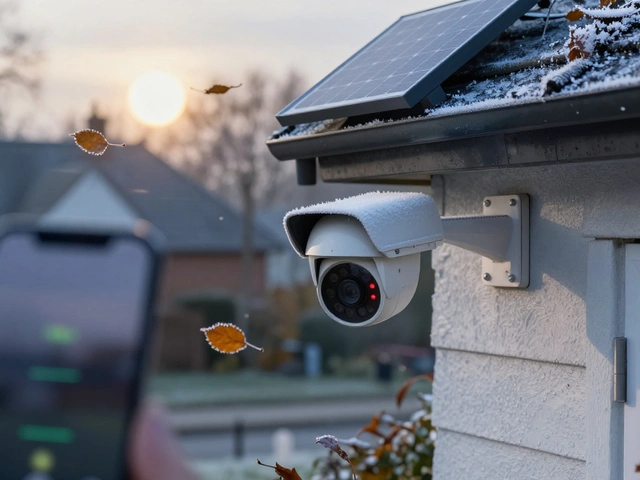If you're a pet owner, installing a security system can be a bit nerve-wracking. The last thing you want is your energetic dog or curious cat setting off alarms at all hours. Enter pet-friendly alarms, designed to recognize the difference between a burglar and a four-legged friend.
So, how do they pull this off? Most of these systems rely on smart motion sensors that adjust for weight and size. They can be set to ignore movement from creatures under a certain weight, keeping tabs only on the larger life forms. It's all about creating a safe space where your pets can roam freely, while you stay worry-free about false alarms.
But hey, nothing is perfect, right? We'll dive into the perks and potential pitfalls of these fancy devices, helping you decide if they're a true fit for your household. Plus, get some handy tips on choosing the right setup that truly caters to your needs and keeps your little companions in mind.
- How Pet-Friendly Alarms Work
- Benefits of Pet-Friendly Alarms
- Popular Types of Sensors
- Possible Downsides
- Choosing the Right System
- Tips for Optimal Use
How Pet-Friendly Alarms Work
Alright, so you've got furry friends at home and you're wondering how on earth a pet-friendly alarm can tell the difference between them and a potential intruder. The magic lies mostly in the motion sensors and a bit of clever tech wizardry.
Most of these alarms have what's called Passive Infrared (PIR) sensors. They literally sniff out heat and movement. A standard motion sensor might go off if it catches anything moving, but pet-friendly ones are tuned to ignore movement under a certain weight, like 40 to 80 pounds. This means your big tabby or medium-sized dog can roam freely while burglars are still caught in the act.
Some systems even use advanced technologies like microwave sensors. These gadgets can distinguish pets from humans by judging the speed and pattern of movement. Pretty smart, right? And if you're worried about setting them up, most come with adjustable settings. It's pretty much like adjusting your steering wheel or seat heights, just a little techier.
Here's a quick look at typical motion detection capabilities for home security with pets:
| Pet Type | Maximum Weight Ignored |
|---|---|
| Small Dog/Cat | Up to 40 lbs |
| Medium Dog | Up to 60 lbs |
| Large Dog | Up to 80 lbs |
Choosing the right settings is key. If your Great Dane keeps triggering the alarm, a tweak is needed. Communication with your system provider is essential for optimal security and comfort.
Benefits of Pet-Friendly Alarms
So, you've got pets and want your home to be secure without those annoying false alarms? That's where pet-friendly alarms shine. These systems are quick to win over pet owners for several solid reasons.
First off, they make life easier. Traditional alarms can go off with just a slight movement of your pet, turning a chill evening into an unnecessary panic. With pet-friendly alarms, motion sensors are designed to tune out those pet-induced movements. Whether it's your cat jumping off a cabinet or your dog wandering the hallway, these sensors essentially ignore movements from your pets.
Another big plus? Less stress. Not just for you, but for your pets too. Imagine your dog freaking out every time the alarm blares. With these specialized systems, you save them—and yourself—from anxiety and chaos, creating a calmer living space.
Security, of course, is core. You're looking out for your home and everyone in it. These alarms keep the bad guys in check without making you switch off the system due to pet-induced false alarms. It’s a win-win situation, balancing effective home security with peace of mind.
And hey, thanks to advances in tech, these systems are more affordable and accessible than ever. You don’t have to break the bank for an elaborate setup. Plus, most systems are plug-and-play, no complex installs needed.
Finally, the convenience of customization is unbeatable. Set sensitivity levels, create zones where pets roam without setting off the alarm, and tweak settings right from your phone. With these alarms, you'll enjoy more control over your security just the way it should be—simple and stress-free.
Popular Types of Sensors
When looking at pet-friendly alarms, it's all about the sensors. These are the gadgets that do the heavy lifting in identifying what's moving around your place. Let's break down some of the most common ones you might come across.
Passive Infrared (PIR) Sensors are the big players here. Most home security systems use them because they detect heat changes. So when your tiny furball scurries across the floor, this sensor knows not to freak out unless it's picking up something bigger and hotter—like a human intruder.
Then you've got Dual-Technology Sensors, which are a combo of PIR and microwave sensors. This team-up is like getting a second opinion every time something moves. They first check for heat changes and then verify with a second method to minimize false alarms triggered by pets.
For those with particularly large or hyper pets, Pet-Immune Motion Sensors might be the go-to. These are fine-tuned to ignore pets up to a certain weight, which you can typically customize. Your dog might weigh about 60 pounds, and these sensors will just shrug at their antics but stay alert for any human-sized movers.
There's also the Vibration Sensors, which aren't foolproof for pet owners but have their place. They detect vibrations on windows or doors, so an active cat trying to escape or a dog jumping at the door might set these off. But in combo with other sensors, they add an extra layer of security.
- Proximity Sensors
- Audible Sensors (like glass break detectors)
- Microphonic Sensors
While choosing a sensor, think about your house layout, your pets' habits, and what makes you feel safe. A mix of these sensors can be your best bet for a secure and peaceful setup.

Possible Downsides
While pet-friendly alarms are a game-changer for many pet owners, they're not without their hiccups. First off, there's the tech factor. These systems rely heavily on motion sensors keyed to weight and size. But if your pet likes to make sudden jumps or has an unusual movement pattern, false alarms could still happen. Ever seen a cat leap from the refrigerator? Yep, that might just do it!
Another thing to keep in mind is the compatibility of these systems with existing home security setups. Not every system can be easily integrated with your current tech, which might lead you to spend time and money on upgrades or replacements.
Additionally, if you own multiple animals with varying sizes, the sensors might need constant adjustments. What works for a Chihuahua might not suit a Great Dane, and managing these settings could become a chore.
Then there's the cost factor. Because they're specialized, these alarms can be pricier than standard systems. You're paying for technology crafted to differentiate between, say, a sizable Labrador and a potential intruder.
Also, some pet-friendly systems aren't foolproof, especially in extremely windy or stormy conditions. Weather can play tricks on sensor accuracy, potentially leading to false negatives or positives. This can be a headache if you're relying on these alarms for peace of mind while you're away.
Lastly, if you're someone who loves DIY projects, setting up a pet-friendly alarm system might prove a tad challenging. The intricacies involved require precision to ensure the settings are just right for ignoring your furry pals.
Choosing the Right System
Picking the ideal pet-friendly alarm system can feel like a chore with all the options out there. But getting it right means you can rest easy knowing your home is secure without frustrating false alerts from your dog or cat.
First things first, think about the size and nature of your pets. Are they jumpers or chill loungers? This impacts the sensitivity settings you'll need. Also, make sure the sensors you choose can ignore pets by weight—for most systems, adjusting for pets up to 80 pounds is a norm.
Brands like ADT and Frontpoint have systems specifically tailored for pet owners. They come with flexible settings that let you fine-tune to your unique home and animal sizes. When browsing, look for systems with motion sensors that don’t trigger below a certain weight threshold. This is crucial for avoiding those dreaded false alarms.
Don't forget your layout. If you have open spaces or tall furniture that your pets love climbing, you’ll want those sensors positioned carefully. Maybe think about a mix of window and door contacts instead of relying only on motion sensors.
Simplicity meets functionality with smart technology integration. Consider systems that connect with your smart home devices. Imagine being able to control your alarms and monitor activities remotely—no more unexpected surprises when you get back home!
Lastly, budget is always key. Don’t just go for the priciest, hoping it’s best. Look for cost-effective options with positive reviews from fellow pet owners.
Here's a quick checklist when choosing:
- Pet weight compatibility
- System adjustability
- Integration with smart devices
- Customer reviews and ratings
- Cost vs. features
This careful consideration and planning pave the way for not just effective home security, but a smoother ride with your beloved pet pals living freely without unnecessary disruptions.
Tips for Optimal Use
Maximizing the potential of your pet-friendly alarms can make a big difference in how effective they'll be at keeping your home safe without annoying false alarms. Here are some handy tips to keep everything running smoothly:
- Placement is Key: Position your motion sensors at a height where pets are least likely to trigger them. Usually, placing them a little higher on the wall works since your pets typically stay low to the ground.
- Understand Sensitivity Settings: Many motion sensors come with adjustable sensitivity. Make sure to adjust these according to the size of your pet. Test it out to find the right balance.
- Frequent Testing: Regularly test your system to ensure it's working right. This helps catch any issues early, keeping both you and your furry pals happy.
- Keep Up Maintenance: Dust and dirt can sometimes mess with sensor performance. Keep them clean for consistent efficiency.
- Know Your Tech: Different systems might have smart features, like connecting to an app. Familiarize yourself with these tools to make use of remote control or instant notifications.
If you're interested in some data, a recent survey showed that houses with pet-friendly alarms reported 35% fewer false alarms than those with standard systems. This kind of info just underlines how important it is to have the right setup for pet owners.
Got some new insights? Implementing these practices can give you peace of mind and help your household blend seamlessly with technology. After all, your home should be a safe haven for everyone, human or pet!






